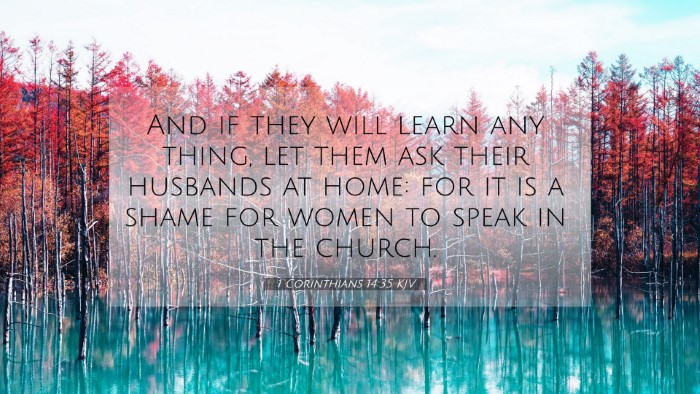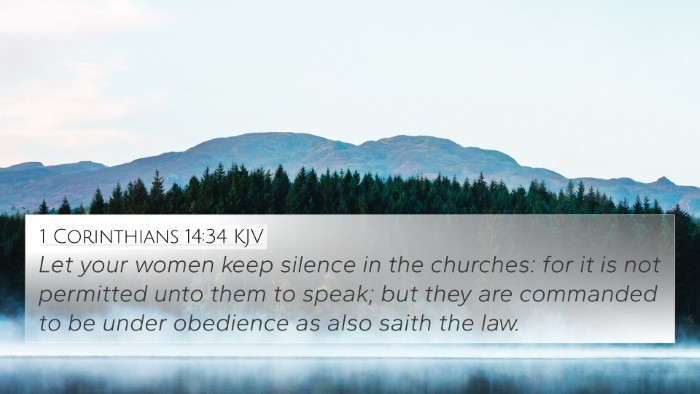Meaning and Interpretation of 1 Corinthians 14:35
The verse 1 Corinthians 14:35 states: "And if they will learn any thing, let them ask their husbands at home: for it is a shame for women to speak in the church." This passage has sparked much discussion and a variety of interpretations throughout church history.
Below, we summarize insights from several public domain commentaries to provide a deeper understanding of this scripture and its implications within the broader context of the New Testament teachings.
Commentary Insights
-
Matthew Henry's Commentary:
Henry emphasizes that the emphasis on conduct within the church services is of utmost importance. He suggests that when it refers to women asking questions, it is about maintaining order and propriety during worship. The implication is that this behavior is linked to proper decorum rather than a complete prohibition of women speaking in any church context.
-
Albert Barnes' Notes:
Barnes suggests the verse addresses the cultural context of Corinth, where public speaking was often chaotic. He highlights that Paul's instructions aimed to ensure harmony and a constructive learning environment. Women were encouraged to learn and seek answers in a way that aligned with societal norms, reinforcing the idea of home as a space for further discussion.
-
Adam Clarke's Commentary:
Clarke argues that the Apostle Paul made these remarks not to suppress women's voices but rather to manage the confusion that arose during worship. He interprets the passage as a reflection of the cultural norms of the time. Clarke highlights that women should use their voices wisely and appropriately in church settings, mirroring how they might engage in conversations at home.
Exegesis and Context
To fully grasp the meaning of 1 Corinthians 14:35, it is essential to consider the surrounding passages, which discuss the orderly conduct of spiritual gifts and public worship. The broader theme of 1 Corinthians is Paul’s admonitions to unify the church and respect the diverse roles within it.
-
Context of Worship:
Paul's directions are aimed at maintaining order: 1 Corinthians 14:33 states, "For God is not the author of confusion, but of peace, as in all churches of the saints." This reinforces that Paul's guidelines for church behavior are rooted in a desire for peace.
-
Cultural Sensitivity:
Considering the Greco-Roman cultural backdrop, which often limited female participation in public discourse, this verse's implications are more about adhering to social conduct within a Christian framework at that time than suggesting a permanent prohibition for women.
Related Bible Cross References
Understanding this verse is enhanced by examining related passages in the Bible. Below are some key cross-references that provide thematic connections:
- 1 Timothy 2:11-12: Discusses women's roles in learning and authority in church settings.
- Galatians 3:28: Points to equality in Christ, which may provide a broader context for understanding the roles of women in the church.
- Acts 2:17-18: Highlights the inclusion of women in spiritual gifts and prophecy.
- 1 Corinthians 11:5: Discusses women prophesying with their heads covered, suggesting that women were indeed vocal participants in early church worship.
- Ephesians 5:22-24: Discusses the roles of wives and husbands, hinting at the domestic context Paul mentions in 1 Corinthians 14:35.
- Romans 16:1-7: Acknowledges female leaders in the early church, including Phoebe and Junia, thus illustrating the active role of women.
- 1 Peter 3:1: Talks about the relationship between husbands and wives, resonating with the domestic aspect indicated in the Corinthians passage.
- Proverbs 31:26: Emphasizes the wisdom of a woman, enhancing the understanding of learning in the home.
- Colossians 3:16: Encourages teaching and admonishing one another, which can involve various members of the church community.
- Titus 2:3-5: Highlights the teaching of older women to younger women, similarly focusing on the home as a context for learning.
Thematic Connections
The broader narrative of the Scriptures provides several thematic connections regarding how women are perceived in spiritual communities. The unity, love, and peace that Paul calls for reflect a larger biblical theme of harmony, a guiding principle that extends beyond gender roles.
For those engaged in Bible cross-referencing and Bible concordance studies, understanding these connections offers profound insights into the roles and responsibilities outlined throughout scripture, reinforcing the importance of context in interpretation.
Conclusion
In summary, 1 Corinthians 14:35 must be viewed through the lens of its cultural context, the overarching message of order within worship, and the potential for women's voices in the church. By examining related scriptures and engaging in a comparative analysis of biblical texts, readers can appreciate the nuances of Paul's teachings and their implications for contemporary church practices.








